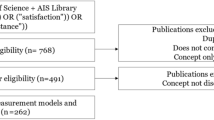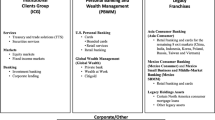Abstract
This paper examines the tie between the popular “black box” neoclassical quantity-setting firm under demand uncertainty and a firm with a rudimentary but explicit “employee relation” organizational structure in which workers are offered fixed wages for following management directives. Surprisingly, the quantity-setting firm unambiguously mimics optimal employment relation hiring and work rules when the contract is incentive-compatible ex post. The attitude toward risk is shown to be the key determinant of whether or not the quantity-setting firm replicates the optimal employment relation contract when ex post incentive-compatibility is relaxed.
Similar content being viewed by others
References
Appelbaum, E., and Katz, E. (1986): “Measures of Risk Aversion and Comparative Statics of Industry Equilibrium.”American Economic Review 76: 524–529.
Batra, R. N., and Ullah, A. (1974): “Competitive Firm and the Theory of Input Demand under Price Uncertainty.”Journal of Political Economy 82: 537–548.
Drago, R., and Turnbull, G. K. (1991): “Market Incentives and Work Incentives: The Question of Flexible Production.”International Economic Review 32: 77–84.
Hartman, R. (1976): “Factor Demand with Output Price Uncertainty.”American Economic Review 66: 675–681.
Holthausen, D. M. (1976): “Input Choices and Uncertain Demand.”American Economic Review 66: 94–103.
Ishii, Y. (1989): “Measures of Risk Aversion and Comparative Statics of Industry Equilibrium: Correction.”American Economic Review 79: 285–286.
Lazear, E., and Rosen, S. (1981): “Rank-Order Tournaments as Optimum Labor Contracts.”Journal of Political Economy 89: 841–864.
Nalbantian, H. R. (Ed.) (1988):Incentives, Cooperation, and Risk Sharing. Lanham, MD: Rowman and Littlefield.
Nalebuff, B., and Stiglitz, J. (1983): “Prizes and Incentives: Towards a General Theory of Compensation and Competition.”Bell Journal of Economics 14: 21–43.
Menezes, C. F., and Hanson, D. L. (1970): “On the Theory of Risk Aversion.”International Economic Review 11: 481–487.
Sandmo, A. (1971): “On the Theory of the Competitive Firm Under Price Uncertainty.”American Economic Review 61: 65–73.
Shapiro, C., and Stiglitz, J. (1984): “Equilibrium Unemployment as a Worker Discipline Device.”American Economic Review 74: 433–444.
Simon, H. A. (1951): “A Formal Theory of the Employment Relationship.”Econometrica 19: 293–305.
Author information
Authors and Affiliations
Rights and permissions
About this article
Cite this article
Turnbull, G.K. Incentive compatibility and the quantity-setting competitive firm under demand uncertainty. Journal of Economics Zeitschrift für Nationalökonomie 58, 77–90 (1993). https://doi.org/10.1007/BF01234802
Received:
Revised:
Issue Date:
DOI: https://doi.org/10.1007/BF01234802




